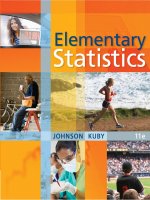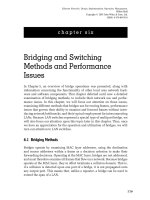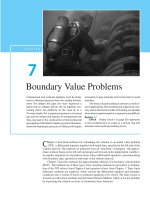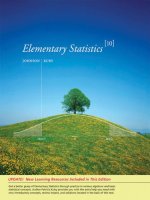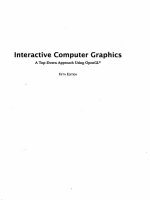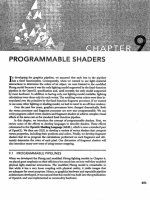Ebook Computer science (9th edition) Part 1
Bạn đang xem bản rút gọn của tài liệu. Xem và tải ngay bản đầy đủ của tài liệu tại đây (11.02 MB, 267 trang )
computer
Sc i en ce
An Overview
Publisher: Greg Tobin
Senior Acquisitions Editor: Michael Hirsch
Editorial Assistant: Lindsey 'Itiebel
Text Designer: Gillian Hall, The Aardvark Group
Cover Design Supervisor: Joyce Cosentino Wells
Cover Designer: Night & Day
Digital Assets Manager: Marianne Groth
Media Producer: Bethany Tidd
Marketing Manager: Michelle Brown
Marketing Assistant: Dana Lopreato
Senior Prepress Supervisor: Caroline Fell
Project Management: Keith Henry/Dartmouth Publishing, Inc.
Composition and Illustrations: Dartmouth Publishing, Inc.
Cover image: © 2005 David Philips
If you purchased this book within the United States or Canada you should be aware that
it has been wrongfully imported without the approval of the Publisher or the Author.
Many of the designations used by manufacturers and sellers to distinguish their products
are claimed as trademarks. W here those designations appear in this book, and Addison
Wesley was aware of a trademark claim, the designations have been printed in initial caps
or all caps.
Copyright © 2007 Pearson Education, Inc. All rights reserved. No part of this publica
tion may be reproduced, stored in a retrieval system, or transmitted, in any form or
by any means, electronic, mechanical, photocopying, recording, or otherwise, with
out the prior written permission of the publisher. Printed in the United States of Amer
ica. For information on obtaining permission for use of material in this work, please
submit a written request to Pearson Education, Inc., Rights and Contracts Depart
ment, 75 Arlington Street, Suite 300, Boston, MA 02116, fax your request to 617-84 8704 7, or e- mail at />ISBN 0 - 321-43445-5
1 2 34 56 7 8 9 1O-EB- 09 0 8 07
To my parents
Garland and Reba Brookshear
This book presents an introductory survey of computer science. It explores the breadth
of the subject while including enough depth to convey an honest appreciation for the
topics involved.
Audience
I wrote this text for students of computer science as well as students from other dis
ciplines. As for computer science students, most begin their studies with the illusion
that computer science is programming and Web browsing since that is essentially all
they have seen. Yet computer science is much more than this. In turn, beginning
computer science students need exposure to the breadth of the subject in which they
are planning to major. Providing this exposure is the theme of this book. It gives stu
dents an overview of computer science-a foundation from which they can appreci
ate the relevance and interrelationships of future courses in the field. This survey
approach is, in fact, the model used for introductory courses in the natural sciences.
This broad background is also what students from other disciplines need if they
are to relate to the technical society in which they live. A computer science course
for this audience should provide a practical, realistic understanding of the entire field
rather than merely an introduction to using the Internet or training in the use of
some popular software packages. There is, of course, a proper place for training, but
this text is about educating. As the old Chinese proverb says: "Give a man a fish and
you feed him for a day. Teach a man to fish and you feed him for a lifetime."
Previous editions of this text have been used successfully in courses for students
over a wide range of disciplines and educational levels, ranging from high school to
graduate courses. This edition is designed to continue that tradition.
New in the Ninth Edition
The most noteworthy changes reflected in this ninth edition are in Chapter 4 (Net
working and the Internet), Chapter 7 (Software Engineering), and Chapter 10 (Artifi
cial Intelligence). Although the table of contents for these chapters has changed little,
the material inside has been expanded, updated, and rearranged significantly. In
Chapter 4 the coverage of networking fundamentals, XML and HTML, and security
7
8
Preface
has been expanded; Chapter 7 has been overhauled and now includes a more precise
introduction to UML; and Chapter 10 has been extensively rewritten.
Less dramatic changes in other chapters include the following: In Chapter 1, a sub
section on flash memory devices has been added and the section on data compression
has been rewritten (LZ77 compression was replaced by LZW and material on com
pressing audio and video was added). In Chapter 2, material on USB and FireWire
has been added. In Chapter 3, the introductory section as well as the section on secu
rity has been rewritten. In Chapter 6, the subsection on linking and loading has been
deleted. In addition, many small changes have been made throughout the text to pro
vide clear, up- to- date, and relevant coverage of topics.
Organization
This text follows a bottom-up arrangement of subjects that progresses from the con
crete to the abstract-an order that results in a sound pedagogical presentation in
which each topic leads to the next. It begins with the fundamentals of information
encoding and computer architecture (Chapters 1 and 2), progresses to the study of
operating systems (Chapter 3) and computer networks (Chapter 4), investigates the
topics of algorithms, programming languages, and software development (Chapters 5
through 7), explores issues of data structures and databases (Chapters 8 and 9), con
siders future applications of computer technology via artificial intelligence (Chapter
lO), and closes with an introduction to the theory of computation (Chapter 11).
Although the text follows this natural progression, the individual chapters and
sections are surprisingly independent and can usually be read as isolated units or
rearranged to form alternative sequences of study. Indeed, the book is often used as
a text for courses that cover the material in a variety of orders. One of these alterna
tives begins with materia] from Chapters 5 and 6 (Algorithms and Programming Lan
guages) and returns to the earlier chapters as desired. In contrast, I know of one
course that starts with the material on computability from Chapter 11 . In still other
instances the text has been used in "senior capstone" courses where it serves as a
backbone from which to branch into projects in different areas.
On the opening page of each chapter, I have used asterisks to mark some sec
tions as optional. These are sections that cover topics of more specific interest or per
haps explore traditional topics in more depth. My intention is merely to provide
suggestions for those looking for alternative paths through the text. There are, of
course, other shortcuts. In particular, if you are looking for a quick read, I suggest the
following sequence:
Section
1 .1-] .4
2.1 -2.3
3.]-3.3
4.1-4.3
'lbpic
Basics of data encoding and storage
Machine architecture and machine language
Operating systems
Networking and the Internet
To Instructors
5. 1-5.4
6. 1-6.4
7. 1-7.2
8. 1-8.2
9. 1-9.2
10.1-10.3
11. 1-11.2
Algorithms and algorithm design
Programming languages
Software engineering
Data abstractions
Database systems
Artificial intelligence
Theory of computation
There are several themes woven throughout the text. One is that computer sci
ence is dynamic. The text repeatedly presents topics in a historical perspective, dis
cusses the current state of affairs, and indicates directions of research. Another theme
is the role of abstraction and the way in which abstract tools are used to control com
plexity. This theme is introduced in Chapter 0 and then echoed in the context of oper
ating system architecture, algorithm development, programming language design,
software engineering, data representation, and database systems.
To Instructors
There is more material in this text than can normally be covered in a single semes
ter, so do not hesitate to skip topics that do not fit your course objectives or to rearrange
the order as you see fit. You will find that, although the text follows a plot, the topics
are covered in a largely independent manner that allows you to pick and choose as
you desire. I wrote the book to be used as a course resource-not as a course defini
tion. I myself like to cover some topics as reading assignments and to encourage stu
dents to read the material not explicitly included in my course. I think we underrate
students ifwe assume that we have to explain everything in class. We should be help
ing them learn to learn on their own.
I feel obliged to say a few words about the bottom-up, concrete-to-abstract organ
ization of the text. I think as academics we too often assume that students will appre
ciate our perspective of a subject-often one that we have developed over many years
of working in a field. As teachers I think we do better by presenting material from the
student's perspective. This is why the text starts with data representation/storage,
machine architecture, operating systems, and networking. These are topics to which
students readily relate-they have most likely heard terms such as JPEG and MP3,
they have probably recorded data on CDs and DVDs, they have purchased computer
components, they have interacted with an operating system, and they have used the
Internet. By starting the course with these topiCS, I see my students discovering
answers to many of the "why" questions they have been carrying for years and learn
ing to view the course as practical rather than theoretical. From this beginning it is
natural to move on to the more abstract issues of algorithms, algorithmic structures,
programming languages, software development methodologies, computability, and
complexity, which those of us in the field view as the main topics in the science. As
I've said before, the topics are presented in a manner that does not force you to fol
low this sequence, but I encourage you to give it a try.
9
10
Preface
We are all aware that students learn a lot more than we teach them directly, and
the lessons they learn implicitly are often better absorbed than those that are stud
ied explicitly. This is significant when it comes to "teaching" problem solving. Stu
dents do not become problem solvers by studying problem-solving methodologies.
They become problem solvers by solving problems-and not just carefully posed "text
book problems." So I have included numerous problems throughout the text, a few of
which are intentionally vague -meaning that there is not a single correct answer. I
encourage you to use these and to expand on them.
Another topic that I place in this "implicit learning" category is that of profes
sionalism, ethics, and social responsibility. I do not believe that this material should
be presented as an isolated subject. Instead, it should surface when it is relevant,
which is the approach I have taken in this text. You will find that Sections 3.5, 4.5,
7.8, 9.7, and 10.7 present such topics as security, privacy, liability, and social aware
ness in the context of operating systems, networking, database systems, software
engineering, and artificial intelligence. Moreover, Section 0.6 introduces this theme
by summarizing some of the more prominent theories that attempt to place ethical
decision making on a philosophically firm foundation. You will also find that each
chapter includes a collection of questions called Social Issues that challenge students
to think about the relationship between the material in the text and the society in
which they live.
Thank you for considering my text for your course. Whether you do or do not
decide that it is right for your situation, I hope that you find it to be a contribution to
the computer science education literature.
Pedagogical Features
This text is the product of many years of teaching. As a result, it is rich in pedagogi
cal aids. Paramount is the abundance of problems to enhance the student's partici
pation-over 1,000 in this ninth edition. These are classified as Q]Jestions & Exercises,
Chapter Review Problems, and Social Issues. The Questions & Exercises appear at the
end of each section (except for the introductory chapter). They review the material
just discussed, extend the previous discussion, or hint at related topics to be covered
later. These questions are answered in Appendix F.
The Chapter Review Problems appear at the end of each chapter (except for the
introductory chapter). They are designed to serve as "homework" problems in that they
cover the materia] from the entire chapter and are not answered in the text.
Also at the end of each chapter are questions in the Social Issues category. They
are designed for thought and discussion. Many of them can be used to launch research
assignments culminating in short written or oral reports.
Each chapter also ends with a list called Additional Reading that contains references
to other materials relating to the subject of the chapter. The websites identified in
this preface, in the text, and in the sidebars of the text are also good places to look for
related material.
To Students
Supplemental Resources
A variety of supplemental materials for this text are available at the book's compan
ion website:
•
www.aw . eorn/brookshear. The following are accessible to all readers:
Chapter-by-chapter activities that extend topics in the text and provide oppor
tunities to explore related topics;
•
•
Software simulators for the example machine used throughout Chapter 2; and
Chapter-by-chapter "selftests" that help readers to rethink the material covered
in the text
In addition, the following supplements are available to qualified instructors at
Addison-Wesley's Instructor's Resource Center. please visit www . aw .
com / i re or con
tact your Addison-Wesley sales representative for information on how to access them:
•
Instructor's Guide with answers to the Chapter Review Problems;
•
PowerPoint lecture slides; and
•
Testbank
You may also want to check out my personal website at www . rnses . rnu. edu/ -g lennb.
It is not very formal (and it is subject to my whims and sense of humor). but I tend to keep
some information there that you may find helpful.
To Students
I'm a bit of a nonconformist (some of my friends would say
more than a bit) so when
I set out to write this text J didn't always follow the advice] received. In particular.
many argued that certain material was too advanced for beginning students. But I
believe that if a topic is relevant, then it is relevant even if the academic community
considers it to be an "advanced topic." You deserve a text that presents a complete
picture of computer science-not a watered-down version containing artificially sim
plified presentations of only those topics that have been deemed appropriate for intro
ductory students. Thus. I have not avoided topics. Instead I've sought better
explanations. I've tried to provide enough depth to give you an honest picture of what
computer science is all about. As in the case of spices in a recipe, you may choose to
skip some of the topiCS in the following pages. but they are there for you to taste if you
wish -and] encourage you to do so.
I should also point out that in any course dealing with technology, the details
you learn today may not be the details you will need to know tomorrow. The field is
dynamic-that'S part of the excitement. This book will give you a current picture of
the subject as well as a historical perspective. W ith this background you will be pre
pared to grow along with technology. I encourage you to start the growing process now
by exploring beyond this text. Learn to learn.
Thank you for the trust you have placed in me by choosing to read my book. As
an author
I
have an obligation to produce a manuscript that is worth your time. ]
hope you find that I have lived up to this obligation.
11
12
Preface
Acknowledgments
I first thank those of you who have supported this book by reading and using it in pre
vious editions. I am honored.
W ith each new edition, the list of those who have contributed to the book as
reviewers and consultants grows. Today this list includes J. M. Adams, C. M. A llen, D.
C. S. Allison, R. Ashmore, B. Auernheimer, P. Bankston, M. Barnard, P. Bender, K.
P. W. Brashear, C. M. Brown, B. Calloni, M. Clancy, R. T. Close, D. H. Cooley,
L. D. Cornell, M. J. Crowley, F. Deek, M. Dickerson, M. J. Duncan, S. Fox, N. E. Gibbs,
J. D. Harris, D. Hascom, L. Heath, P. B. Henderson, L. Hunt, M. Hutchenreuther, L.
Bowyer,
A. Jehn, K. K. Kolberg, K. Korb, G. Krenz, J. Liu, T. J. Long, C. May, W McCown, S.
J. Merrill, K. Messersmith, J. C. Moyer, M. Murphy, J. P. Myers, Jr. , D. S. Noonan, S.
Olariu, G. Rice, N. Rickert, C. Riedesel, J. B. Rogers, G. Saito, W Savitch, R. Schlafly,
J. C. Schlimmer, S. Sells, G. Sheppard, Z. Shen, J. C. Simms, M. C. Slattery, J. Slim
ick, J. A. Slomka, D. Smith, J. Solderitsch, R. Steigerwald, L. Steinberg, C. A. Struble,
P. Tonellato, P. Tromovitch, E. D. W inter, E. Wright,
Th these individuals I give my sincere thanks.
C. L. Struble, W J. Taffe, J. Talburt,
M. Ziegler, and one anonymous.
A special thank you goes to Roger Eastman who played a significant role in the
rewrite of Chapter
10
(Artificial Intelligence). I think you will find that his input has
produced a significantly better presentation of the subject. Roger is also the source of
much of the supporting materials at the text's website. I greatly appreciate his efforts.
I also thank the people at Addison-Wesley who have contributed to this project.
They are a great bunch to work with-and good friends as well. [f you are thinking
about writing a textbook, you should consider having it published by Addison-Wesley.
] continue to be grateful to my wife Earlene and daughter Cheryl who have been
tremendous sources of encouragement over the years. Cheryl, of course, grew up and
left home several years ago. But Earlene is still here. I'm a lucky man. On the morn
ing of December
11, 1998, I survived a heart attack because she got me to the hospi
tal in time. (For those of you in the younger generation I should explain that surviving
a heart attack is sort of like getting an extension on a homework assignment.)
Finally, I thank my parents, to whom this book is dedicated.
I
close with the fol
lowing endorsement whose source shall remain anonymous: "Our son's book is really
good. Everyone should read it."
J. G. B.
Chapter 0
Introduction
0.]
0.2
0.3
0. 4
0. 5
0.6
Chapter 1
Chapter 2
19
53
79
Computer Architecture 9 6
Machine Language 99
Program Execution 105
Arithmetic/Logic Instructions 113
Communicating with Other Devices
Other Architectures 123
Operating Systems
3. 1
3.2
3.3
*3.4
3.5
20
Bits and Their Storage 36
Main Memory 43
Mass Storage 46
Representing Information as Bit Patterns
The Binary System 60
Storing Integers 65
Storing Fractions 72
Data Compression 77
Communication Errors 82
Data Manipulation
2. 1
2.2
2.3
*2.4
*2.5
*2.6
Chapter 3
The Role of Algorithms 18
The Origins of Computing Machines
The Science of Algorithms 25
Abstraction 26
An Outline of Our Study 27
Social Repercussions 29
Data Storage
1.1
1.2
1.3
1.4
*1.5
* 1.6
*1. 7
*1.8
*1.9
1
118
119
The History of Operating Systems 136
Operating System Architecture 140
Coordinating the Machine's Activities 147
Handling Competition Among Processes 150
Security 155
Astensks indicate suggestions for optional sections.
*
..
13
14
Contents
Chapter 4
Networking and the Internet
4.1
4.2
4.3
*4.4
4.5
Chapter 5
Algorithms
5.1
5.2
5.3
5.4
5.5
5.6
Chapter 6
147
Network Fundamentals 164
The Internet 1 73
The World Wide Web 1 80
Internet Protocols 1 90
Security 196
195
The Concept of an Algorithm 21 2
Algorithm Representation 215
Algorithm Discovery 223
Iterative Structures 229
Recursive Structures 240
Efficiency and Correctness 249
Programming Languages
251
Historical Perspective 268
Traditional Programming Concepts 277
Procedural Units 288
Language Implementation 296
*6.5 Object-Oriented Programming
305
*6.6 Programming Concurrent Activities 311
*6.7 Declarative Programming 314
6. 1
6.2
6.3
6.4
Chapter 7
Software Engineering
7.1
7.2
7.3
7.4
7.5
7.6
7.7
7.8
Chapter 8
311
The Software Engineering Discipline 328
The Software Life Cycle 331
Software Engineering Methodologies 335
Modularity 337
Thols of the Trade 344
'Testing 352
Documentation 354
Software Ownership and Liability 355
Data Abstractions
349
Data Structure Fundamentals 366
Implementing Data Structures 371
A Short Case Study 386
Customized Data Types 39l
Classes and Objects 395
*8.6 Pointers in Machine Language 397
8.1
8.2
8.3
8.4
*8.5
Chapter 9
Database Systems
391
9 . 1 Database Fundamentals 408
9.2 The Relational Model 41 3
Contents
*9.3
*9.4
*9.5
9.6
9.7
Object-Oriented Databases 424
Maintaining Database Integrity 427
Traditional File Structures 430
Data Mining 439
Soc ia l Impact of Database Technology
Chapter 10 Artificial Intelligence
10.1
10.2
10.3
10.4
10.5
10.6
10.7
435
I ntelligence and Machines 452
Perception 457
Reasoning 463
Additional Areas of Research 476
Artificial Neural Networks 480
Robotics 489
Considering the Consequences 491
Chapter 11 Theory of Computation
11.1
11.2
11.3
1 1.4
11.5
*11 . 6
A
B
C
D
E
F
585
485
Functions and Their Computation 502
Thring Machines 504
Universal Programming Languages 509
A Noncomputable Function 515
Complexity of Problems 520
P ublic-Key Cryptography 529
525
Appendixes
Index
441
ASCII 543
Circuits to Manipulate 'TWo's Complement
Representations 545
A Si mple Machine Language 549
High-Level Language Program Examples 551
The Equivalence of Iterative and Recursive
Structures 559
Answers to Questions & Exercises 561
15
Introduction
0.1 The Role of Algorithms
0.2 The Origins of Computing
Machines
0.3 The Science of Algorithms
0.4 Abstraction
I n this preliminary chapter we consider
the scope of computer science, develop a
historical perspective, and establish a foun
dation from which to launch our study.
0.5 An Outline of OUr Study
0.6 Social Repercussions
18
Introduction
Computer science is the discipline that seeks to build a scientific foundation for such top
ics as computer design, computer programming, information processing, algorithmic
solutions of problems, and the algorithmic process itself. It provides the underpinnings
for today's computer applications as well as the foundations for tomorrow's applications.
This book provides a comprehensive introduction to this science. We will investi
gate a wide range of topics including most of those that constitute a typical university
computer science curriculum. We want to appreciate the full scope and dynamics of
the field. Thus, in addition to the topics themselves, we will be interested in their his
torical development, the current state of research, and prospects for the future. Our goal
is to establish a functional understanding of computer science-one that will support
those who wish to pursue more specialized studies in the science as well as one that
will enable those in other fields to flourish in an increasingly technical society.
o. 1 The Role of Algorithms
We begin with the most fundamental concept of computer science-that of an algo
rithm. Informally, an
algorithm is a set of steps that defines how a task is performed.
(We will be more precise later in Chapter 5.) For example, there are algorithms for
cooking (called recipes), for finding your way through a strange city (more commonly
called directions), for operating washing machines (usually displayed on the inside of
the washer's lid or perhaps on the wall of a laundromat), for playing music (expressed
in the form of sheet music), and for performing magic tricks (Figure
0.1).
Before a machine such as a computer can perform a task, an algorithm for per
forming that task must be discovered and represented in a form that is compatible
with the machine.
A representation
of an algorithm is called a
program.
For the con
venience of humans, computer programs are usually printed on paper or displayed on
computer screens. For the convenience of machines, programs are encoded in a man
ner compatible with the technology of the machine. The process of developing a pro
gram, encoding it in machine-compatible form, and inserting it into a machine is called
programming. Programs, and the algorithms they represent, are collectively referred
to as software, in contrast to the machinery itself, which is known as hardware.
The study of algorithms began as a subject in mathematics. Indeed. the search for
algorithms was a significant activity of mathematicians long before the development
of today's computers. The goal was to find a single set of directions that described
how all problems of a particular type could be solved. One of the best known exam
ples of this early research is the long division algorithm for rmding the quotient of two
multiple-digit numbers. Another example is the Euclidean algorithm, discovered by
the ancient Greek mathematician Euclid, for finding the greatest common divisor of
two positive integers (Figure
0.2).
Once an algorithm for performing a task has been found. the performance of that
task no longer requires an understanding of the principles on which the algorithm is
based. Instead, the performance of the task is reduced to the process of merely fol
lowing directions. (We can follow the long division algorithm to find a quotient or the
Euclidean algorithm to find a greatest common divisor without understanding why the
0.1 The Role of Algorithms
Figure O. 1 An algorithm for a magic trick
Effect: The performer places some cards from a normal
deck of playing cards face down on a table and mixes
them thoroughly while spreading them out on the table.
Then, as the audience requests either red or black cards,
the performer turns over cards of the requested color.
Secret and Patter:
Step 1.
Step 2.
Step 3.
From a normal deck of cards, select ten red cards
and ten black cards. Deal these cards face u p
i n two piles on t h e table according t o color.
Announce that you have selected some red cards
and some black cards.
Pick up the red cards. Under the pretense of aligning
them into a small deck, hold them face down i n your
left hand and, with the thumb and first finger of your
right hand, pull back on each end of the deck so that
each card is g iven a slightly backward curve. Then
place the deck of red cards face down on the table
as you say, "Here are the red cards in this stack."
Step 4.
Pick up the black cards. In a manner similar to that
in step 3, g ive these cards a slight forward cu rve.
Then return these cards to the table in a face-down
deck as you say, "And here are the black cards i n
this stack."
Step 5.
Immediately after returning the black cards to the
table, use both hands to mix the red and black
cards (still face down) as you spread them out
on the tabletop. Explain that you are thoroughy
mixing the cards.
Step 6.
As long as there are face-down cards on the table,
repeatedly execute the following steps:
6. 1 . Ask the audience to request either a red or a
black card.
6.2. If the color requested is red and there is a
face-down card with a concave appearance,
turn over such a card while saying,
"Here is a red card."
6.3. If the color requested is black and there is a
face-down card with a convex appearance,
turn over such a card while saying,
"Here is a black card."
6.4. Otherwise, state that there are no more cards
of the requested color and turn over the
remaining cards to prove your claim.
19
20
Introduction
Figure 0.2 The Euclidean algorithm for finding the greatest common divisor of two positive integers
Description: This algorithm assumes that
its input consists of two positive integers
and proceeds to compute the g reatest
common divisor of these two values.
Procedure:
Step 1. Assig n M and N the value of the
larger and smaller of the two
i n put values, respectively.
Step 2. Divide M by N, and call the
remainder R.
Step 3. If R is not O. then assign M the
value of N, assign N the value of R.
and return to step 2; otherwise,
the greatest common divisor is
the value cu rrently assigned to N.
algorithm works.) In a sense, the intelligence required to solve the problem at hand
is encoded in the algorithm.
It is through this ability to capture and convey intelligence (or at least intelligent
behavior) by means of algorithms that we are able to build machines that perform use
ful tasks. Consequently, the level of inte1ligence displayed by machines is limited by
the intelligence that can be conveyed through algorithms. We can construct a machine
to perform a task only if an algorithm exists for performing that task. In turn, if no algo
rithm exists for solving a problem, then the solution of that problem lies beyond the
capabilities of machines.
Identif}ring the limitations of algorithmic capabilities solidified as a subject in
mathematics in the
1930s with the publication of Kurt Gbdel's incompleteness theo
rem. This theorem essentially states that in any mathematical theory encompassing
our traditional arithmetic system, there are statements whose truth or falseness can
not be established by algorithmic means. In short, any complete study of our arith
metic system lies beyond the capabilities of algorithmic activities.
This realization shook the foundations of mathematics, and the study of algorithmic
capabilities that ensued was the beginning of the field known today as computer science.
Indeed, it is the study of algorithms that forms the core of computer science.
0.2 The Origins of Computing Machines
Thday's computers have an extensive genealogy. One of the earlier computing devices
was the abacus. Its history has been traced as far back as the ancient Greek and Roman
civilizations. The machine is quite simple, consisting of beads strung on rods that are
in turn mounted in a rectangular frame (Figure
0.3). As the beads are moved back and
0.2 The Origins of Computing Machines
Figure 0.3 An abacus (photography by Wayne Chandler)
forth on the rods, their positions represent stored values. It is i n the positions of the
beads that this "computer" represents and stores data. For control of an algorithm's exe
cution, the machine relies on the human operator. Thus the abacus alone is merely
a data storage system; it must be combined with a human to create a complete com
putational machine.
In more recent years, the design of computing machines was based on the tech
nology of gears. Among the inventors were Blaise Pascal (1623-1662) of France, Gott
fried Wilhelm Leibniz (1646-1716) of Germany, and Charles Babbage (1792-187l) of
England. These machines represented data through gear positioning, with data being
input mechanically by establishing initial gear positions. Output from Pascal's and
Leibniz's machines was achieved by observing the final gear positions. Babbage, on
the other hand, envisioned machines that would print results of computations on
paper so that the possibility of transcription errors would be eliminated.
As for the ability to follow an algorithm, we can see a progression of flexibility in
these machines. Pascal's machine was built to perform only addition. Consequently,
the appropriate sequence of steps was embedded into the structure of the machine
itself. In a similar manner, Leibniz's machine had its algorithms firmly embedded in its
architecture, although it offered a variety of arithmetic operations from which the oper
ator could select. Babbage's Difference Engine (of which only a demonstration model
was constructed) could be modife
i d
lytical Engine (the construction for which he never received funding) was designed to
read instructions in the form of holes in paper cards. Thus Babbage's Analytical Engine
21
22
Introduction
Augusta Ada Byron
Ever since the US Department of Defense named a programming language in her
honor, Augusta Ada Byron, Countess of Lovelace, has been the subject of much
commentary in the computing community. Ada Byron lived a somewhat tragic
life of less than 37 years (1815-1852) that was complicated by poor health and the
fact that she was a nonconformist in a SOCiety that limited the professional role of
women. She became fascinated by the machines of Charles Babbage when she
witnessed a demonstration of a prototype of his Difference Engine in 1833. Her
contribution to computer science involved her translation from French into Eng
lish of a paper discussing Babbage's designs for the Analytical Engine. 'Ib this
translation, Babbage encouraged her to attach an addendum describing applica
tions of the engine and containing examples of how the engine could be pro
grammed to perform various tasks. Babbage's enthusiasm for Ada Byron's work
was motivated by his hope that its publication would lead to financial backing for
the construction of his Analytical Engine. (As the daughter of Lord Byron, Ada
Byron held celebrity status with potentially significant financial connections.)
This backing never materialized, but Ada Byron's addendum has survived and is
considered to contain the first examples of computer programs. Thus, Augusta
Ada Byron is recognized today as the world's first programmer.
was programmable. In fact, Augusta Ada Byron (Ada Lovelace), who published a paper
in which she demonstrated how Babbage's Analytical Engine could be programmed to
perform various computations, is often identified today as the world's first programmer.
The idea of communicating an algorithm via holes in paper was not originated by
Babbage. He got the idea from Joseph Jacquard (1752-1 834), who, in 1801, had devel
oped a weaving loom in which the steps to be performed during the weaving process
were determined by patterns of holes in paper cards. In this manner, the algorithm
fonowed by the 100m could be changed easily to produce different woven designs.
Another beneficiary of Jacquard's idea was Herman Hollerith (1 860-1 929), who
applied the concept of representing information as holes in paper cards to speed up
the tabulation process in the 1890 U.S. census. (It was this work by Hollerith that led
to the creation onBM.) Such cards ultimately came to be known as punched cards and
survived as a popular means of communicating with computers well into the 1970s.
Indeed, the technique lives on today, as witnessed by the voting issues raised in the
2000 U.S. presidential election.
The technology of the time was unable to produce the complex gear-driven
machines of Pascal, Leibniz, and Babbage in a financially feasible manner. But with
the advances in electronics in the early 1900s, this barrier was overcome. Examples
of this progress include the electromechanical machine of George Stibitz, completed
in 1940 at Ben Laboratories, and the Mark I, completed in 1944 at Harvard University
by Howard Aiken and a group of IBM engineers (Figure 0.4). These machines made
0.2 The Origins of Computing Machines
Figure 0.4 The Mark I computer
heavy use of electronically controlled mechanical relays. In this sense they were obso
lete almost as soon as they were built, because other researchers were applying the
technology of vacuum tubes to construct totally electronic computers. The first of
these machines was apparently the Atanasoff-Berry machine, constructed during the
period from 1937 to 1941 at Iowa State College (now Iowa State University) by John
Atanasoff and his assistant, Clifford Berry. Another was a machine called Colossus,
built under the direction of 'Ibmmy Flowers in England to decode German messages
during the latter part of World War II. (Actually, as many as ten of these machines were
apparently built, but military secrecy and issues of national security kept their exis
tence from becoming part of the "computer family tree.") Other, more flexible
machines, such as the ENIAC (electronic numerical integrator and calculator) devel
oped by John Mauchly and J. Presper Eckert at the Moore School of Electrical Engi
neering, University of Pennsylvania, soon followed.
From that point on, the history of computing machines is been closely linked to
advancing technology, including the invention of transistors and the subsequent devel
opment of integrated circuits, the establishment of communication satellites, and
advances in optic technology. 'Ibday, small hand-held computers have more com
puting power than the room-size machines of the 1940s and can exchange informa
tion quickly via global communication systems.
A major step toward popularizing computing was the development of desktop com
puters. The origins of these machines can be traced to the computer hobbyists who
began to experiment with homemade computers shortly after the development of the
large research machines of the 1940s. It was within this "underground" of hobby activ
ity that Steve Jobs and Stephen Wozniak buil t a commercially viable home computer
23
24
Introduction
8abbage's Difference Engine
The machines designed by Charles Babbage were truly the forerunners of mod
em computer design. If technology been able to produce his machines in an
economically feasible manner and if the data processing demands of commerce
and government been on the scale of today's requirements, Babbage's ideas
could have led to the computer revolution in the 1800s. As it was, only a
demonstration model of his Difference Engine was constructed in his lifetime.
This machine determined numerical values by computing "successive differ
ences." We can gain an insight to this technique by considering the problem of
computing the squares of the integers. We begin with the knowledge that the
square of 0 is 0, the square of 1 is 1, the square of2 is 4, and the square of3 is 9 .
With this, we can determine the square of 4 in the following manner (see the
diagram below). We first compute the differences of the squares we already
know: 12 - 02 = 1, 22 - 12
3, and 32 -22
5. Then we compute the differ
ences of these results: 3 1 2, and 5 3 2. Note that these differences are
both2. Assuming that this consistency continues (mathematics can show that it
does) we conclude that the difference between the value (42 - 32) and the value
(32 22 ) must also be2. Hence (42 - 32) must be2 greater than (32 22), so 42_
32 = 7 and thus 42
32 + 7
16. Now that we know the square of 4, we could
continue our procedure to compute the square of 5 based on the v alues of 12,
22, 32, and 42. (Although a more in-depth discussion of successive differences is
beyond the scope of our current study, students of calculus may wish to
observe that the preceding example is based on the fact that the derivative of
2
y = x is a straight line with a slope of 2.)
=
-
=
=
-
=
-
-
=
=
X
x2
0
0
1
1
2
4
3
9
4
16
5
First
difference
Second
difference
1
3
5
7
2
2
2
2

